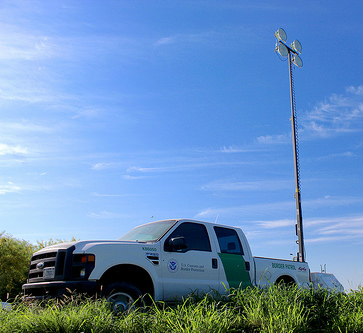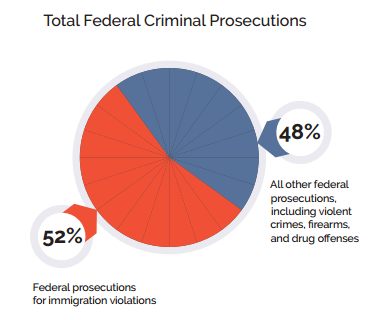The Real Cost of Trump’s Immigration Enforcement Plan
 When it comes to deportation systems, the United States has taken the bigger-is-better approach in recent years. And by the looks of what’s mapped out in Trump’s executive order, agency memos and budget requests, the immigration enforcement plan will only get more massive. Or “wasteful and ineffective” as the American Immigration Lawyers Association (AILA) put it in a recent article.
When it comes to deportation systems, the United States has taken the bigger-is-better approach in recent years. And by the looks of what’s mapped out in Trump’s executive order, agency memos and budget requests, the immigration enforcement plan will only get more massive. Or “wasteful and ineffective” as the American Immigration Lawyers Association (AILA) put it in a recent article.
The piece throws a few numbers around that put Trump’s plan into perspective. For starters, it mentions that for nearly $20 billion (what the U.S. spends annually on immigration enforcement), we are hitting record numbers of U.S. Immigration and Customs Enforcement (ICE) and Customs and Border Protection (CBP) agents and our highest yet number of people deported (more than 400,000 annually) in American history—not to mention hundreds of miles of fencing along our southern border, drones and technology, detention beds and more.
But Trump wants more. Billions more, in fact, in order to:
- Add 15,000 enforcement agents
- Build a border wall covering the whole southwest border
- Increase detention rates (potentially to 80,000 per day)
- Increase federal prosecutions of those entering the U.S. illegally
However, the cost is not just monetary. Excessive at best, Trump’s plan “will deprive thousands of people of due process and humanitarian protections” and fails to provide “any indication of how it was determined that the wall, the detention beds, or the extra agents are even necessary, or how the Administration will decide when the border is reasonably secure,” according to AILA.
Another Brick in the Wall
Border fencing thus far spans 653 miles of our southwest border. But for Trump, that’s not enough. He wants a wall covering all 2,000 miles, despite the fact that CBP is already patrolling every mile of the U.S. border on a daily basis and that head of the Border Patrol Union Brandon Judd (who also supports Trump) recently said, “We do not need a wall along the entire 2,000 miles of border,” during a recent NPR interview.
So what do we stand to gain with the additional construction? The only thing for certain is a big, multibillion-dollar bill. After crunching some numbers, the Department of Homeland Security (DHS) originally estimated that each additional mile of fencing would cost $16 million, bringing the total cost to somewhere between $15 and $25 billion. Recent data shows that the actual cost could hover around $67 billion, instead.
Agents of Change
Trump aims to hire 15,000 more Border Patrol and ICE agents and officers despite significant issues that arose in 2016 when the government doubled the number of ICE agents from 10,000 to 21,000.
Rapidly hiring a mass number of agents proved to be problematic in the past for a few reasons. Not only were the new hires rushed through training and prematurely forced into the field, some didn’t go through proper screening and failed to complete a background check.
What’s worrisome, according to James Tomsheck, the former head of internal affairs at CBP, is that CBP is now considering weakening or skipping one of its screening staples: mandatory polygraph testing. He told NPR during a recent interview that polygraph testing helped, “weed out candidates who had criminal backgrounds and some would-be agents who were members of drug cartels that wanted to infiltrate CBP as spies.” How does lightening up on these requirements make any sense? About the matter, Tomsheck said it’s “beyond my comprehension.”
Simply put, Trump’s plan includes issuing an ICE badge and gun to new ICE immigration enforcement officers without having to undergo a polygraph test. That’s assuming the CBP can find enough candidates. The CBP has had a two-pronged thorn in its side for years when it comes to hiring: Low morale and the failure to find folks who can pass a polygraph. Lucky for them, the latter just might go away.
Shift in Resources
Trump’s plan also calls for an increase in criminal prosecutions for those crossing the border without inspection. What does that mean in the bigger picture of this country’s criminal landscape? When you aim to increase resources on nonviolent, low-level immigration law offenses instead of the nation’s violent crime prosecutions, you decrease the overall safety of those living in the United States. Just consider the number of prosecutions in FY 2016, as demonstrated in the following graph published by AILA:

Does it make sense to increase illegal border prosecutions? Probably not. Throw in the fact that previous measures taken to deter border crossings (a la Operation Streamline) have instead, according to AILA:
- Clogged up the federal courts and wasted precious government resources with little evidence that the program is achieving its goals.
- Resulted in group hearings that violate fundamental due process.
- Wrongfully prosecuted Asylum seekers.
Even if Trump could prove that his bullet-riddled plan to divert millions of dollars from the prosecution of high to low-level crimes would work on the immigration front, are we willing to risk what it means for our country as a whole?
Photo Credit: Piedmont Fossil Flickr via Compfight cc
